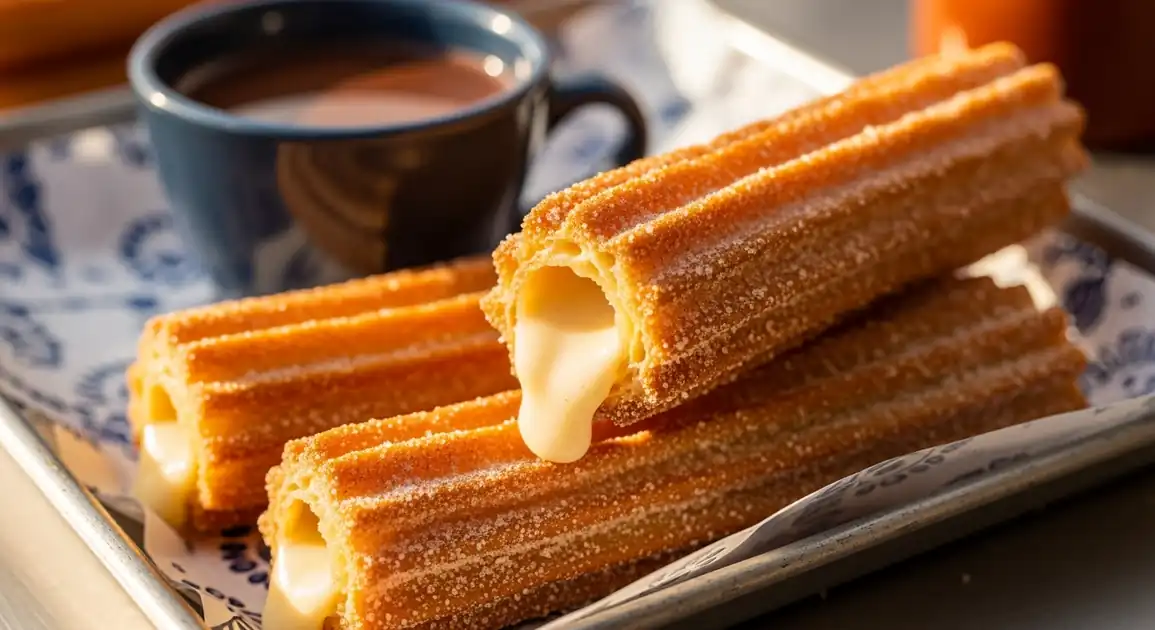Filled Churros
Churros Rellenos

Description
Churros Rellenos can be found throughout Mexico, though they're more common in urban areas than rural regions. While they're available year-round, they're especially popular during evening hours, festivals, and the winter holiday season when their warming qualities are most appreciated. Fillings and preparations vary slightly by region, with northern Mexico favoring cajeta and central Mexico offering more diverse filling options.
Dietary Information
Serving information
Serving style
Typically served in paper bags, on small plates, or wrapped in napkins. Often accompanied by hot chocolate, coffee, or on their own. Usually eaten immediately while standing at the stall or walking.
Quick facts
Most churrerías operate from late morning through evening (11 AM - 10 PM), with many street vendors starting in the afternoon (3 PM onwards).
Safety Tips
What to Look For
-
Freshly fried churros (made to order or in small batches)
Ensures proper cooking temperature is reached, killing potential bacteria, and provides the best texture. Churros should be golden-brown and crispy, not pale or soggy.
-
Clean oil that bubbles vigorously when churros are added
Properly heated, clean oil (around 180-190°C/355-375°F) ensures thorough cooking and prevents greasy, undercooked churros that could cause digestive issues.
-
Proper filling hygiene (refrigerated fillings, clean equipment)
Dairy-based and egg-based fillings (custards, some chocolates) need proper temperature control to prevent spoilage. Look for vendors who keep fillings covered and refrigerated when possible.
-
Proper handling (gloves or frequent hand washing)
Vendors should use gloves, tongs, or wash hands frequently, especially when handling both money and food.
-
High turnover and local popularity
Busy stands ensure fresher ingredients, more frequently changed oil, and generally better quality and safety standards.
What to avoid
-
Pre-filled churros sitting for extended periods
Filled churros should be prepared upon ordering or very recently. Extended time at room temperature allows bacteria to multiply in moist fillings, especially dairy-based ones like custard.
-
Visibly dirty or very dark, smoking oil
Old, reused oil can contain harmful compounds. Good vendors change oil regularly.
-
Unsanitary filling practices (same tools handling different ingredients without cleaning)
Cross-contamination can introduce bacteria or allergens. Watch how the vendor handles fillings.
-
Fillings that look separated, discolored, or have an unusual smell
These are signs of spoilage. Fresh fillings should have consistent color and texture.
-
Uncovered filling containers exposed to air, insects, or dust
Proper food safety requires covering sweet fillings that can attract insects or accumulate environmental contaminants.
Price information
Price range
Budget tips
- Basic street vendors typically offer the most affordable prices (15-25 MXN per churro).
- Specialty shops and tourist areas charge premium prices (30-60 MXN per churro).
- Some vendors offer discounts when buying multiple churros (e.g., 3 for the price of 2).
- Markets often have better prices than dedicated shops or tourist zones.
Value indicators
- Freshly fried to order.
- Generous amount of filling.
- Proper sugar coating.
- Served hot/warm.
- Clean, dedicated equipment for filling.
Where to Find This Dish
Tourist Areas
Especially popular in areas frequented by both domestic and international tourists.
Zócalos (main squares), Popular markets, Shopping districts
Afternoon, Evening, Weekends
Markets (Mercados)
Traditional and modern markets often have at least one churrería.
Municipal markets, Weekly tianguis (street markets)
Market hours (typically morning through afternoon)
Commercial Districts
Found near shopping areas and business centers, catering to workers and shoppers.
Shopping centers, Office complexes, Pedestrian zones
Afternoon, Evening
Vendor Tips
- Ask when they last changed their frying oil - quality vendors change it frequently.
- If you see them making and filling churros fresh, that's a good sign.
- Some vendors let you choose your sugar coating (plain, cinnamon-sugar, or sometimes colorful options).
How to Order
Regional Variations
-
Cajeta (Caramel) Filled Churros
(Churros Rellenos de Cajeta)
The most traditional Mexican filling, made with goat milk caramel that has a distinctive rich, slightly tangy flavor compared to regular caramel.
-
Chocolate Filled Churros
(Churros Rellenos de Chocolate)
Filled with chocolate ganache or chocolate cream, often made with Mexican chocolate that has cinnamon notes.
-
Vanilla Custard Filled Churros
(Churros Rellenos de Crema Pastelera)
Filled with pastry cream (similar to what's found in eclairs), offering a smooth, creamy contrast to the crispy exterior.
-
Fruit Filled Churros
(Churros Rellenos de Fruta)
Typically filled with fruit preserves or compotes, with strawberry (fresa), guava (guayaba), and blackberry (zarzamora) being popular choices.
-
Condensed Milk Filled Churros
(Churros Rellenos de Leche Condensada)
Filled with sweetened condensed milk, sometimes flavored with vanilla or dulce de leche.
-
Cheese Filled Churros (Savory)
(Churros Rellenos de Queso)
A less common savory variation filled with soft cheese like queso fresco or a creamy cheese sauce.
Cultural context
History
While churros originated in Spain and Portugal, Mexico embraced and transformed them into a beloved national street dessert. Churros Rellenos represent Mexico's innovative adaptation, adding fillings to the traditionally hollow pastry. The exact origin of filled churros in Mexico is not well-documented, but they became popular in the mid-20th century as churrería stands evolved. The most famous churro establishment, El Moro, founded in 1935, helped popularize churros throughout Mexico City, though they traditionally serve the unfilled Spanish style with hot chocolate for dipping.
Local significance
Churros represent the Spanish influence on Mexican cuisine but have been embraced as distinctly Mexican through adaptations like fillings. They're considered a special treat rather than everyday food.
Eating customs
- Eaten fresh and warm, often while standing or walking.
- Typically enjoyed as a snack rather than a proper dessert course.
- Often a social food shared among family or friends during outings.